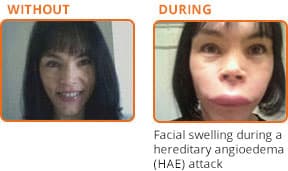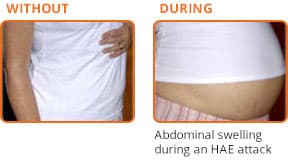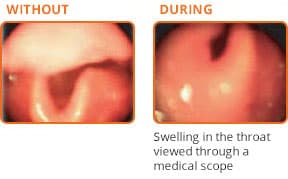Attack Presentation
Symptoms of HAE
Attacks typically cause swelling of the skin/subcutaneous tissues, gastrointestinal tract, and upper airways, some of which may be painful and functionally disabling.1-3
Skin/subcutaneous tissue

Typically affects the face, extremities, and genitals and can be disabling and disfiguring at the time of the attack3
Photos courtesy of US Hereditary Angioedema Association. www.haeimages.com
Gastrointestinal tract

May present with mild to severe abdominal pain accompanied by vomiting and/or diarrhea4
Photos courtesy of US Hereditary Angioedema Association. www.haeimages.com
Upper airway, including the larynx

Laryngeal attacks can cause death by asphyxiation; 50% of patients experience at least 1 laryngeal episode during their lifetime2,4,5,a
aIn a survey of 209 patients.5
Photos courtesy of Bas M, et al. Allergy. 2006;61(12):1490-1492.6
Many patients may experience prodromal symptoms before an HAE attack, including2,7:
- A tingling sensation
- Erythema marginatum, a mild, nonpruritic rash
- Fatigue and malaise
- Nausea
- Muscle aches
- Neurologic symptoms


